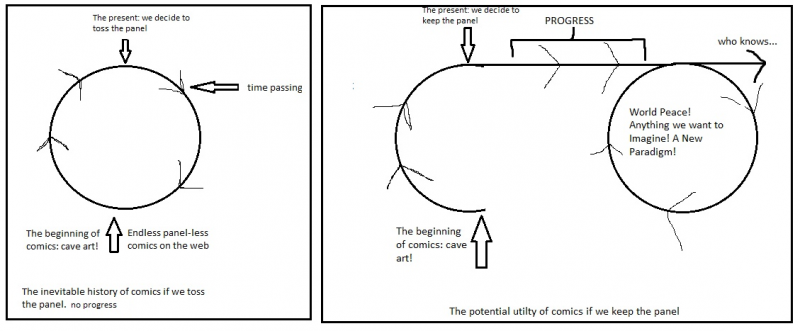Serendip is an independent site partnering with faculty at multiple colleges and universities around the world. Happy exploring!
Notes Towards Day 11 (Tues, Feb. 21): "Visibility Politics"?

[cf. Maguerite Duras: "a word is worth 1,000 pictures...."]
sterrab: I have come to realize that I enjoy reading comics.
I am more of a visual person and tend to be a slow reader, but
what I found to be most intriguing about reading comics is the
suspense in the gutter …. Not referencing the name [Persepolis]…
her story is that of a Persia falling into rubble in a time of revolution…
a hidden story behind the icons.
Ayla: authors write a story to relay a message … Still, there is a
level of uncertainty that is unavoidable….movies … cultivate a rich
discussion and … learning from novels can be endless….our
discussion in class was a debate of which allowed more freedom
of interpretation …Traditionally, we read to escape to worlds that
aren't our own, and we are released into that world by our own
imagination … I think …. there is still a rich learning experience
attached to visual interpretation.
I. coursekeeping
naming
by classtime on Thursday, please finish Satrapi's
second volume, Persepolis 2: The Story of a Return;
this Wed @ 7:30 in Hilles 109: Life After Life
(the evolution of a life's "genre," in the largest sense...)
looking forward to two events next week:
this weekend you have a very specific posting assignment-->
5 p.m. Sun, Feb. 26: post on-line a proposal for the remainder
of our semester's work together. Begin with a paragraph or two
of a mid-semester evaluation of how we're doing in learning together:
what's working? What needs working on? What should we keep,
of our shared practices? What might we change up? Turn then from
questions of "form" to those of "content": make a proposal for our
next set(s) of imaginative test case(s). What evolving genres
would you choose to explore, if the remainder of the class were an
independent study? What do you recommend our exploring together?
Why? (i.e. how do your selections expand/extend/challenge
what we have already done?)
I have two more weeks of material planned for after break
(wiggle room, to order new books, do some course planning),
but we will select material together for
NINE [AS YET UNPLANNED] CLASSES.
the following weekend, 8 p.m. Fri, Mar. 3: second 4-pp. web event,
exploring the evolution of graphic analysis (or: the genre of the
classroom? of the evolving, diverse self? of your first web event?)
conferences welcomed but not required....
e-mail conversations, ditto!
questions?
II. Rich, rich discussion on our Sunday evening digital "diablog":
on whether we are "co-writing" w/ our computers-->
kobieta: computers are the scribes, the translators of our ideas into a different medium….there are times when we fail to give the proper command and the computer "thinks" for itself…the distinction between writer and a tool ... is not intent but thought. Since the computer is merely putting what you wrote on a different platform, it is not co-writing. It's just a translator.
dglasser: Using the word translator to describe computers is perfect …… they act as a way to lessen the gaps between peoples and to filter languages in an appropriate way for each reader or viewer….Margaret Boden … describes that computers are able to be creative beyond what their programmers have laid out in their design … they can tweak conventions in a novel way. For example, … through base programming, computers can tweak already established musical rhythms and conventions and create novel, valuable and artistic progressions in prevoiously established musical styles.
on the [imprecise] definition [and implications] of genre ->
leamirella: My bottom line is ... I don't think that we've looked enough at our definitions of what genre is enough….McCloud, though extremely casual and "chatty", writes non-fiction. Satrapi, on the other hand, is telling a story. This made me realize that the genre of the "comic" or "graphic narrative" is a lot more complex that we imagine …."genre" in literature….are characterized by their content, not by the way they are layed out on the page…comics themselves have content that lends itself to (sometimes multiple) genres…what does genre actually mean and how are we defining it?
EGrumer: I can't believe that I'd never considered this before, but it's completely true. Genre can refer both to content … and to format. Comics are a genre …because they are formatted in a certain way …. The OED … allows for genre to be defined by content or format, but that seems too general. We need better, more specific terms, but I don't know what they are.
KT: I’m thinking about your questions on genre and what McCloud had to say about stereotyping comics …. Until McCloud pointed it out, I had no idea that comics went beyond superheroes … I was a “form” genre-ist (like racist, but with genre) …. I think we can get caught up in what we know we like … In terms of your question about different ways that we define genre (content versus form), that’s an awesome question, I want to say it’s just a category and we use personal preference to determine which category is more important to us, but what influences that personal preference?
on the future of comics ->
vspaeth: McCloud is really selling the idea that comics are their own genre …. However, I realize that comics have not evolved into anything new; they have broken from their bordered boxes into other genres, other media forms … other genres ... feed off of their versatility …. is it this feeding that has been keeping comics from growing into their own, unique, genre?
froggies315:

EGrumer: This genre snobbery… came to mind ….I don't often mention my love of romances in academic circles … an act of cowardice, and rooted in genre stigmas …. All of this has me thinking about… the future of genres. Will comics eventually be respected as evenly as non-graphic stories? Will other genres? What causes a genre to be respectable or not respectable? ….for [an editor talking w/ Neil Gaiman], comics were a disreputable genre, but the same books called "graphic novels" were not.
III. turning now to Satrapi's Persepolis, a test case for our Understanding Comics
[and the "rich learning experience attached to visual interpretation"]:
A few additional "frames":
* graphic narratives boom genre, new category for academic study
first written, published as comic books, in installments
with Art Spiegelman's Maus (which was Satrapi's inspiration),
they began to be used to take on larger historical (more "serious") issues (Holocaust....)
I want us to think together about the relation of Persepolis to this tradition:
in what way is Satrapi's use of the medium of comics important?
how would her story work differently as novel, or in essay form?
how process differently if you see images instead of words?
[cf. leamirella's claim: that what matters is the content, not the form]
Two visual sources identified by Sartrapi herself:
* Persian miniatures ("the drawing itself is very simple," eschewing perspective);
see Bihzad on "trying to paint the world as God would see it and not as we, humans, do."
* avant-garde, black-and-white, expressionistic films like
Murnau's vampire fantasy Nosferatu (1922)
"A woman...is almost continually accompanied by her own image of herself...she comes to consider the surveyor and the surveyed within her as the two constituent yet always distinct elements of her identity as a woman...Her own sense of being in herself is supplanted by a sense of being appreciated as herself by another...women watch themselves being looked at...this determines...the relation of women to themselves...she turns herself into an object--and most particularly an object of vision: a sight" (pp. 46-47).
* and the particular role of veiling in Iran (shielding woman from such a gaze)
* what is the role of a visual medium, in interrupting this historical dynamic??
* how might visuals --especially simple, cartoonish ones--reinforce stereotypes?
Of course caricature is never truly accurate; its job is to exaggerate, it dispenses with detail. This also makes it immune from easy challenge. A caricature bypasses argument. And now that pictures have become central to political life, caricatures have grown even stronger, and caricatured images are joined by caricatures of ideas.
between this genre and gender, between the generic predilections of graphic narratives,
and the gender positions of Satrapi's primary characters and (presumed) readers.
Do some close reading (following Art Spiegelman's observation that "people don't even
have the patience to decode comics ... comics have become one of the last bastions of literacy"):
'The Veil,' p. 3;
'The Bicycle,' (esp. p. 15);
the "Persepolis" chapter (p. 26, discussed by sterrab);
'The Party' (cf. p. 40, p. 42);
'The Heroes' (esp. p. 52);
'The Key' (esp. p. 102); and
'The Cigarette' (esp. p. 117), and

V. Reporting out:
* how accessible, vernacular is this form? how mass its appeal?
* why is it black and white? what are the effects of this minimalist drawing style?
* how child-like is the perspective? how "feminist"?
* what can we say about the representation of trauma?
* does drawing seem more "fictional" than prose? less "transparent"?
* look especially @ the unique artificial borders of the panels,
focusing on the effect of the gutters between them.
Satrapi's stark style is monochromatic -- there is no evident shading technique; she offers flat black and white .... "the depiction of deliberately empty spaces" ... visual emptiness of the simple, ungraded blackness in the frames shows memory's ... thickness, its depth .... ... frequent scenes in which public skirmishes appear as stylized and even symmetrical formations of bodies ... The minimalist play of black and white ... to present events with a pointed degree of abstraction in order to call attention to the horror of history ...
"Violence today has become something so normal, so banal ... But it's not normal. To draw it and put it in color -- the color of flesh and the red of the blood, and so forth -- reduces it by making it realistic" .... Persepolis is devastatingly truthful and yet stylized ... style as a narrative choice ... is fundamental to understanding graphic narrative ... pared-down techniques of line and perspective ... as with abstract expressionism, which justifies a flatness of composition to intensify affective content ... is a sophisticated, and historically cognizant, means of doing the work of seeing.
present mass death in a highly stylized fashion .... almost architectural ... a child's too-tidy conceptualization ... and the disturbing, anonymous profusion of bodies ....
the pitfalls of other, ostensibly transparent representational modes: "I cannot take the idea of a man cut into pieces and just write it. It would not be anything but cynical. That's why I drew it" ... from a child's (realistically erroneous but emotionally, expressionistically informed) perspective ....
... no perspective, however informed, can fully represent trauma .... it is in "excess of our frames of reference" .... [In] a child's imaging of torture ... one recognizes not only the inadequacy of any representation to such traumatic history, but also ... the simultaneous power of the radically inadequate (the child's naive confusion).
combining on a page ... the historical "routine" (execution) and the personal "routine" (sneaking cigarettes) ... uses understated graphic idiom to convey the horror of her "story of a childhood." Persepolis shows trauma as ordinary, both in the text's form -- the understated, spatial correspondences Persepolis employs to narrative effect through comics panelization -- and in style: the understated quality of Satrapi's line that rejects the visually laborious ... to departicularize the singular witnessing ... to open out the text ... while Persepolis may show trauma as (unfortunately) ordinary, it rejects the idea that it is (or should ever be) normal ....
Persepolis offers not simply a "visibility politics," but an ethical and troubling visual aesthetics...
| Attachment | Size |
|---|---|
| Werts.jpg | 190.29 KB |


